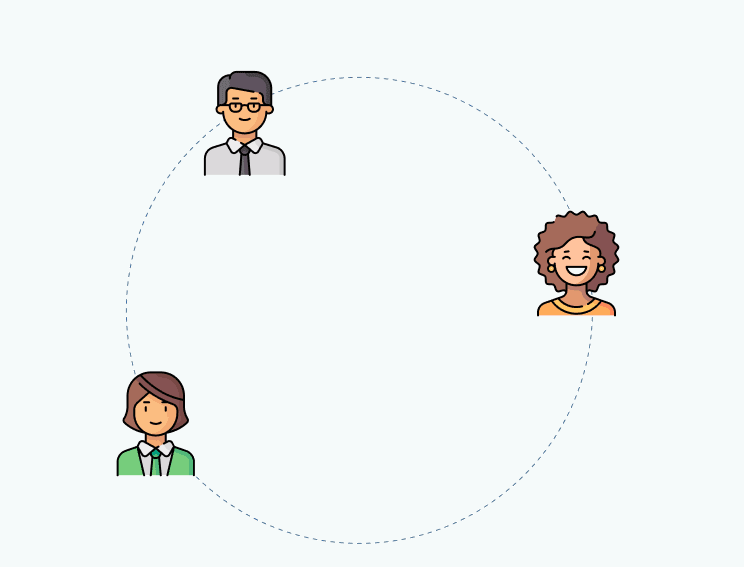
Your New Intranet Starts Here
Streamline communication, boost collaboration, and empower your team with MyHub's intuitive intranet solution.
Book a live demo now and experience the difference.
Take a Quick TourThe average person spends a third of their life at work, which is a mind-blowing statistic. In comparison, only a small fraction of our time is spent with family and friends. With so much of our lives tied to the workplace, it’s clear that work has a major influence on our overall quality of life. That’s why building a vibrant workplace community is essential. A connected, engaging work environment fosters a sense of belonging and emotional well-being that every employee needs. However, under the pressure of meeting targets and deadlines, the human element can be overlooked. With trends like the Great Resignation still looming, organizations must prioritize culture and connection to retain top talent. Here’s a timely reminder of why community at work matters – plus ten proven strategies to strengthen it without blowing the budget.
What Is A Work Community?
You’ve likely seen it plastered across job ads: “a great place to work” or “excellent company culture.” But what does a real work community look like beyond the buzzwords?
A strong workplace community is built on a foundation of shared purpose and mutual trust. It brings meaning to work that goes beyond paychecks and task lists. When a community thrives, employees feel a deep sense of inclusion and connection. This positive atmosphere fosters team spirit, loyalty, and a sense of ownership. Your people not only understand their roles but feel like they genuinely matter. Companies that cultivate vibrant internal communities often share these key characteristics:
- Every worker is respected and heard
- Feedback and participation are actively encouraged
- Teams collaborate and work towards shared goals
- Employees have access to the tools and training they need to succeed
- Knowledge sharing and peer support are part of the daily routine
- Communication is open, transparent, and multi-directional
- There are frequent opportunities for social connection in relaxed settings
Why Is Community Important At Work?
You might think, “My team seems happy and we’re hitting our targets – so what’s the big deal?” On the surface, things might appear fine. But often, beneath the surface, employees may feel disconnected, especially in remote or hybrid teams where screens can create emotional distance.
According to research by Cigna, nearly a third of U.S. workers report feeling a sense of disconnection and loneliness at work. These feelings aren’t just emotional – they have measurable business costs, including reduced productivity, increased sick leave, and higher employee turnover. The study notes that fostering real human connection at work can dramatically improve performance and well-being.
Supporting that idea, Gallup reports that businesses with a strong workplace community are more likely to build teams that are productive, engaged, and loyal. This makes community building a critical component of business success.
It’s important not to confuse company culture with community. While culture defines the values and mission driven from leadership, the workplace community is grassroots – it’s shaped by how your people interact, collaborate, and support one another daily.
How Do You Build Team Community?
The best news? Building a team community doesn’t require a big budget or fancy initiatives. With a few intentional strategies, you can create a sense of connection and belonging that resonates throughout your organization. These approaches are flexible and work whether your team is in-office, remote, or hybrid. Start with small, consistent actions that show employees they matter, and you’ll see the long-term benefits of a strong, connected workplace.
10 Best Practice Ideas To Develop Your Work Community
1. Prioritize Onboarding
A great workplace community starts from day one. Those first few weeks are vital and can make or break a recruit’s long-term engagement with your organization. That’s why it’s essential to prioritize a structured employee onboarding process that makes new hires feel genuinely welcome and aligned with your company values.
Whether your onboarding is in person or virtual, ensure new team members get access to the right tools, helpful documentation, and contact with relevant team members. Assign a buddy as their go-to resource, schedule informal meet-and-greets, and organize a virtual or in-person team lunch. These social touchpoints accelerate connection-building and help the new employee feel like a valued part of your workplace community from day one.
2. Set Up Regular Team Huddles
Short, casual huddles – online or in person – are perfect for strengthening team communication and nurturing a positive workplace culture. A quick 15-minute check-in helps build human connection, especially in remote teams.
Use team huddles to share personal wins, recognize contributions, and provide quick project updates. They also offer a space to brainstorm solutions, share roadblocks, and support one another. By providing a regular platform for open communication and encouragement, team huddles reinforce trust and foster collaborative momentum.
3. Give Everyone A Voice
According to Forbes, 74% of staff who feel heard say they perform better at work. Giving employees a voice at work is essential for employee engagement and retention.
Use pulse surveys, anonymous Q&A forums, town halls, or informal lunch-and-learns to encourage open dialogue. These initiatives help identify team concerns, spark new ideas, and strengthen trust between staff and leadership. Be prepared to listen and act on feedback – this shows your commitment to meaningful two-way communication.
4. Find Out What Staff Really Think
Not everyone feels confident sharing their thoughts in public. That’s why it’s important to implement anonymous employee surveys and feedback tools to gather honest insights.
Annual engagement surveys provide a broad view of employee sentiment, while quick pulse surveys help address specific issues in real time. Focus groups also offer valuable qualitative feedback. Regular check-ins like these allow you to track improvements and benchmark your progress against industry standards.
5. Develop A Culture Of Appreciation
Recognition is a powerful motivator. Building a culture of appreciation helps employees feel valued and part of something meaningful.
Encourage regular shoutouts in team chats or meetings, create formal recognition programs, and celebrate wins – big or small. Don’t forget peer-to-peer recognition; allowing colleagues to acknowledge each other builds mutual respect and reinforces community bonds.
6. Strengthen Team Bonds
Personal connections are the foundation of a thriving work community. Create informal spaces like lounges, coffee corners, or breakout areas where people can relax and chat.
Even in remote settings, virtual #watercooler channels or Zoom catchups can foster those important human moments. Casual conversations help employees feel connected, improve collaboration, and make the workplace more enjoyable.
7. Promote Team Building
Strong teams are built on shared experiences. Organize regular team building activities – from company retreats to simple lunch outings or online quizzes – to strengthen relationships and improve morale.
Involve employees in planning these activities to make sure they feel inclusive and fun for everyone. Whether in person or virtual, time spent bonding outside of work tasks leads to stronger cooperation and trust back on the job.
8. Encourage Volunteering Programs
Community outreach builds a feel-good factor within your company. Launching corporate volunteering programs boosts morale and reflects positively on your brand.
Organize charity drives, local clean-ups, or group volunteering days. Support the causes your employees care about, and highlight those contributions in company communications to reinforce a shared purpose.
9. Support Knowledge Sharing
A culture of knowledge sharing encourages teamwork and continuous learning. Employees often learn best from each other, and sharing insights leads to innovation and stronger team performance.
Host lunch-and-learns, create explainer videos, or run peer-led workshops to make information exchange simple and engaging. It’s a great way to highlight in-house expertise while building connections across departments.
10. Share Workers’ Bios And Personal Stories
Employee profiles offer a powerful way to build relationships – especially in hybrid or remote teams. Modern staff directories go beyond names and job titles. They allow employees to share their roles, projects, and personal interests.
Encourage employees to include hobbies, fun facts, or family stories in their bios. These personal touches humanize your team and help spark real conversations, which are essential to building an authentic workplace community.
Ready To Build Your Workplace Community?
Community creates a powerful sense of belonging and brings deeper meaning to our daily work lives. Instead of simply clocking in and completing tasks, a thriving workplace community adds value, purpose, and human connection – factors that enhance our overall quality of life.
There are also many measurable benefits for employers. A strong workplace culture improves employee engagement, boosts motivation, drives productivity, and increases retention. These outcomes directly impact your bottom line and long-term success.
Of course, creating a workplace community doesn’t happen overnight. It can feel overwhelming at first – but it doesn’t have to be. Start small by implementing a few of the best practice ideas outlined above. Use them as building blocks to gradually foster a more connected and collaborative workplace culture.
Investing time and effort into building this kind of community is one of the smartest strategic moves a company can make. It not only sets you apart from the competition but also strengthens your employer brand, which is especially important in the face of talent shortages and the ongoing effects of the Great Resignation.
So, what are you waiting for? Start creating a workplace community that both you and your employees will be proud to be part of – one that supports well-being, encourages collaboration, and aligns everyone around a shared mission.
MyHub provides cloud-hosted intranet solutions designed to support and grow workplace communities. Our easy-to-use platform is quick to set up, customizable to your needs, and consistently rated highly on independent review sites. Discover how organizations across industries use MyHub to enhance internal communication and strengthen employee connections. Book a free demo or start your 14-day no-obligation trial today to learn more.
FAQ Section
What is the difference between company culture and workplace community?
Company culture is shaped by organizational values and leadership, setting the tone for behavior and expectations. In contrast, a workplace community is grassroots-driven, reflecting the collective ideals and behaviors of employees, fostering a sense of belonging and mutual support.
How can onboarding contribute to building a strong work community?
Effective onboarding ensures new employees feel welcomed and integrated into the team. By providing them with the necessary tools, information, and introductions, organizations can help new hires build connections and understand their role within the community from the outset.
Why is open communication important in a workplace community?
Open communication fosters transparency, trust, and collaboration. When employees feel they can share ideas, feedback, and concerns without fear of retribution, it leads to a more cohesive and engaged workforce, enhancing overall productivity and morale.



